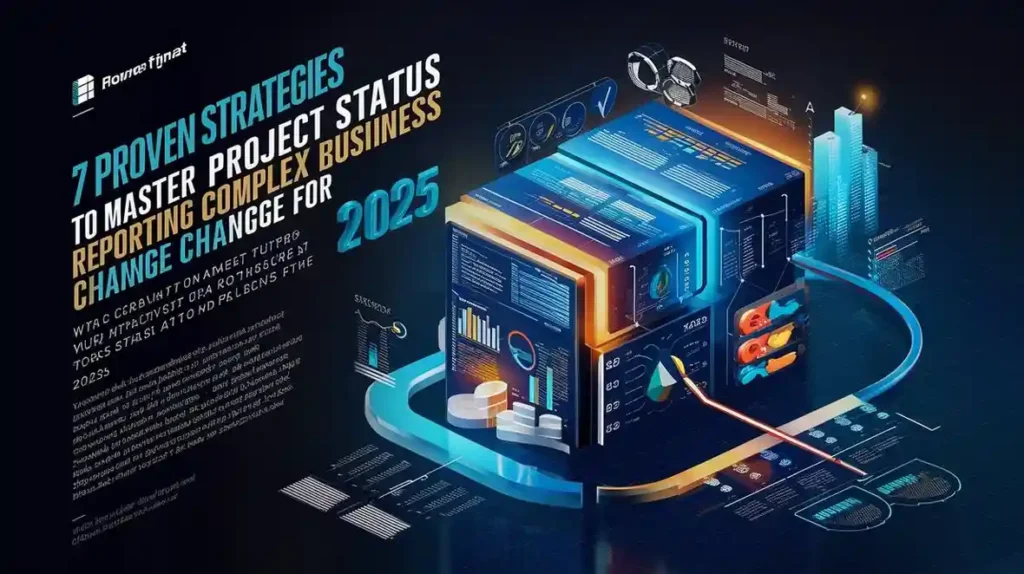Introduction
Ever delivered a project status reporting update only to hear, “Why didn’t we know about this sooner?” For seasoned project managers leading complex business change—think multi-team, high-stakes transformations—nailing status reporting is both an art and a science. Too much detail drowns decision-makers in noise; too little hides risks until they explode. With 8-30 years of experience, you’ve likely seen both extremes.
So, how do you ensure your reports tell the full story—not just a polished facade? Can you blend structured data with real-time qualitative insights? Are qualitative interviews worth the effort to unearth hidden issues? This guide is for PMs overseeing intricate initiatives, offering proven strategies to optimize project status reporting, surface risks early, and foster collaboration. Quick tip: Next report, ask yourself, “Would I bet my bonus on this being complete?” Let’s transform your reporting game for 2025!
Why Project Status Reporting Falls Short
Common Traps to Avoid
- Over-Sanitization: Risks are downplayed to “keep the peace,” masking reality.
- Data Overload: Pages of metrics bury insights—like finding a needle in a haystack.
- Inconsistent Formats: Teams report differently, leaving leadership piecing together a puzzle.
- Blind Spots: Focus on known issues misses brewing problems.
The Cost of Ineffective Reports
- Surprise Crises: Risks surface late, derailing timelines (e.g., a 2024 survey found 60% of PMs faced unexpected delays due to poor reporting).
- Eroded Trust: Leadership loses faith when reports don’t match reality.
- Missed Opportunities: Hidden issues delay proactive fixes.
Expert Tip: If execs uncover issues outside your reports, it’s a red flag—time to rethink your approach.
Balancing Quantitative and Qualitative Reporting
Strengths and Limits of Each
- Quantitative Reporting (Data-Driven)
- Best For: KPIs, milestones, RAG statuses, dashboards.
- Strengths: Clear, comparable, leadership-friendly.
- Limits: Masks nuance (e.g., a “green” status hiding team burnout).
- Qualitative Reporting (Narrative Insights)
- Best For: Risks, morale, cross-team dynamics.
- Strengths: Reveals what numbers miss—like early warning signs.
- Limits: Subjective and time-intensive to gather.
Finding the Sweet Spot
- Blend Both: Pair a dashboard with a “soft signals” section for context.
- Prioritize Relevance: Focus data on what drives decisions, qualitative on what drives risks.
- Adjust by Phase: Early stages need more qualitative; execution leans on quantitative.
- pmi.org for reporting templates.
Success Story: A PM added a two-sentence qualitative summary to a RAG report—leadership caught a $200K risk before it hit the numbers.
7 Strategies to Uncover Hidden Issues
Smarter Reporting Techniques
- Focus on What Matters: Report on risks, dependencies, and blockers—not fluff
- Enhance RAG with Context: Add “Why?” to each status (e.g., “Amber: Vendor delay, ETA +2 weeks”).
- Incorporate Soft Signals: Include a section for team sentiment or emerging concerns.
- Standardize Across Teams: Use a unified template to roll up insights seamlessly.
- Track Confidence Levels: Ask teams to rate their milestone certainty (e.g., 80% confident).
- Highlight Dependencies: Call out cross-team handoffs prone to delays.
- Flag Trends: Note patterns (e.g., “Third week of resource strain”) for proactive fixes.
Building a Risk-Savvy Culture
- Encourage Candor: Reward honest reporting over sugarcoating.
- Anonymous Channels: Offer a safe way to surface sensitive risks.
- Train Teams: Teach leads to spot and report early warning signs.
Expert Tip: Test a “What’s Not in the Numbers?” section—teams project status reporting often reveal gold here.
Are Qualitative Interviews Worth It?
Qualitative interviews can transform business change reporting, but are they practical for busy PMs? Let’s weigh it out.
Benefits and Challenges
- Benefits:
- Catch risks before data reflects them (e.g., team friction).
- Strengthen trust with open dialogue.
- Map hidden dependencies across silos.
- Challenges:
- Time-heavy: 15-20 minutes per lead adds up.
- Risk of fatigue: Over-asking burns out teams.
- Analysis lag: Turning insights into action takes effort.
Making Them Efficient
- Keep It Tight: Limit to 3 questions: “What’s working? What’s at risk? What do you need?”
- Rotate Focus: Interview high-risk teams weekly, others monthly.
- Summarize Fast: Use bullet points to share findings in reports.
Expert Tip: Start with a pilot—interview two leads and compare insights to your dashboard. Worth it? Scale up.
Case Study: Revamping Reporting for Business Change
The Problem and Fix
A $50M digital transformation at a global retailer suffered from sanitized project status reporting. Risks—like a failing vendor—hit late, forcing firefighting. Their overhaul:
- Built a hybrid model: Dashboards for KPIs, biweekly interviews for context.
- Added a “Confidence Score” (e.g., “70% sure we’ll hit Q2 deadline”).
- Tracked soft signals: Team leads flagged morale dips early.
Results and Insights
- 40% Fewer Surprises: Risks surfaced weeks earlier.
- Leadership Buy-In: Execs praised actionable clarity.
- Team Alignment: Cross-functional gaps closed 25% faster.
Key Takeaway: Data plus dialogue beats data alone—every time.
Conclusion
For PMs with 8-30 years of experience, project status reporting is your lens into complex business change. Key takeaways:
- Ditch sanitized fluff for insights that matter.
- Blend quantitative precision with qualitative depth.
- Use interviews to catch what metrics miss.
Next Steps:
- Audit your current project status reporting—where’s the blind spot?
- Pilot a hybrid report with one team next sprint.
- Standardize a template with RAG, context, and soft signals.
- Schedule your first qualitative check-in this week.
Step into 2025 with
Discover 7 brutal truths about whether anyone can be a project manager here.—it empowers. Lead smarter, not harder!








